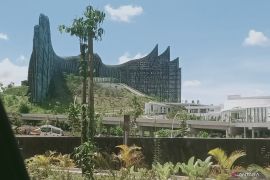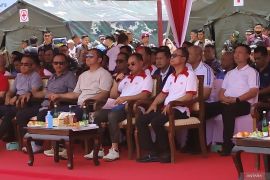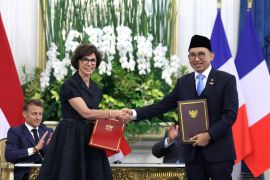At the same time, Palu in Central Sulawesi, is the largest raw rattan producer in the country. Hence, Cirebon rattan entrepreneurs who are members of the Indonesian Furniture and Handicraft Industry Association (Himki) are eager to expand their business to the area with abundant rattan raw materials, namely Palu.
After all, Minister of Industry Airlangga Hartarto advised that rattan processing industry operating in Java should expand their business to Palu, Central Sulawesi. "We want to invite furniture industry in Cirebon to go to Palu and see abundant source of rattan raw material there," he said when visiting several furniture factories in Cirebon on Saturday (Nov 3).
Moreover, rattan industry in Central Sulawesi has yet to be developed to its maximum potential. The establishment of the Central Sulawesi National Rattan Innovation Center (Pirnas) three years ago is, however, expected to boost the development of national rattan industries through the availability of new rattan furniture designs and services.
The building of the first Indonesian rattan innovation center is located in an industrial area within Palu`s Special Economic Zone (KEK).
Central Sulawesi province is the biggest rattan producer in Indonesia, contributing 60 percent of the world`s rattan supplies. This makes Indonesia the world`s largest rattan producer.
Hartarto said the center can be utilized by business people. "We ask that some of the initial process of furniture work be done in Palu to become part of the reconstruction of Palu," he said.
In this case, Hartarto said that the government had built various facilities to support furniture production in Palu.
Some of these facilities include production areas, production equipment to warehouses to store products that have been produced.
"The government will build factory and businesses should send people to produce components there. So, here (in Cirebon) the components are assembled during the finishing stage," he said.
Pirnas is expected to be able to encourage the national rattan industry by developing new and innovative rattan furniture designs.
The presence of the rattan innovation center is part of the government`s move to develop an agro-based processing industry in Palu, amid the establishment of a special economic zone (SEZ).
Meanwhile, General Chairman Himki, Soenoto, in Cirebon, expressed readiness to make business expansion in Palu.
"It is very possible (expansion in Palu). There are already a lot of machines from Java that are stationed there," he said in Cirebon on Saturday.
According to him, one of the challenges of the furniture industry in expanding to Palu is about the availability of human resources (HR).
In the initial stage, human resources to be employed in Palu will be brought from Java, to provide training to the local people.
"So we will also bring workers from here (Cirebon). Then, technical assistance will be provided there. For example, one person can train five people. It will take a long time but it must be started," said Soenoto. Before the end of 2018, he added, business people who are members of Himki will visit the National Rattan Innovation Center (Pirnas) made by the Ministry of Industry in Palu to conduct an observation.
Himki and the Ministry of Industry are committed to developing the furniture and craft industry in Indonesia as much as possible. On the same occasion, Minister of Industry Airlangga Hartarto stressed that the Ministry of Industry would facilitate rattan processing businesses to expand to Palu.
"Let us review Palu, when Himki is ready, we will accompany it. There are already business facilities, raw materials and tools, warehouses, so what remains to be done is to bring people from Java to work there," said the Minister of Industry.
Thus, he called on furniture and handicraft entrepreneurs grouped in Mimki to also promote its products and boost exports.
"Don`t immediately set an export target of 5 billion US dollars. For the time being it should be set at 4 billion US dollars. We will support this furniture industry to continue to increase exports, " Hartarto said during a working visit to the rattan processing industry in Cirebon, West Java, on Saturday.
Airlangga stressed that the government had secured rattan raw material by stopping its exports so that it could be utilized maximally by domestic businesses.
"Therefore, if entrepreneurs could not boost the exports of their rattan products, we will allow the exportation of raw rattan," Hatato said jokingly.
The export performance of the Indonesian furniture industry in the past three years showed a trend that tended to stagnate, where in 2015 it reached 1.71 billion US dollars, in 2016, 1.61 billion US dollars and in 2017 amounted to 1.63 billion US dollars.
Meanwhile, the value of world furniture trade based on data from the Center for Industrial Studies (CSIL) is 130 billion US dollars in 2015, 131 billion US dollars in 2016, and 138 billion US dollars in 2017.
From these data it can be seen that Indonesia`s role in world furniture exports is still relatively small compared to the potential of existing raw materials.
Until October 2017, data at the Indonesian Rattan Entrepreneurs Association (APRI) showed that Indonesia`s sustainable rattan potential exceeds the need for rattan raw materials for the national industry.
"National rattan needs are only 5 to 10 percent of the total potential of sustainable Indonesian rattan resources," said Deputy General Chair of the Indonesian Rattan Entrepreneurs Association (APRI) Julius Hoesan, previously.
The potential of sustainable Indonesian raw rattan is 630,000 tons per year. When processed into semi-finished goods it stood at 250,000 tons per year. There are still many that are not used by the industry.
Indonesia is the largest rattan producer in the world. 40 types of commercial rattan are produced in Indonesia while industry only uses six to seven types of commercial rattan.
"That is only a small portion of these types of commercial rattan," said Hoesan noted.
Editing by Suharto
Reporter: Andi Abdussalam
Editor: Suharto
Copyright © ANTARA 2018












